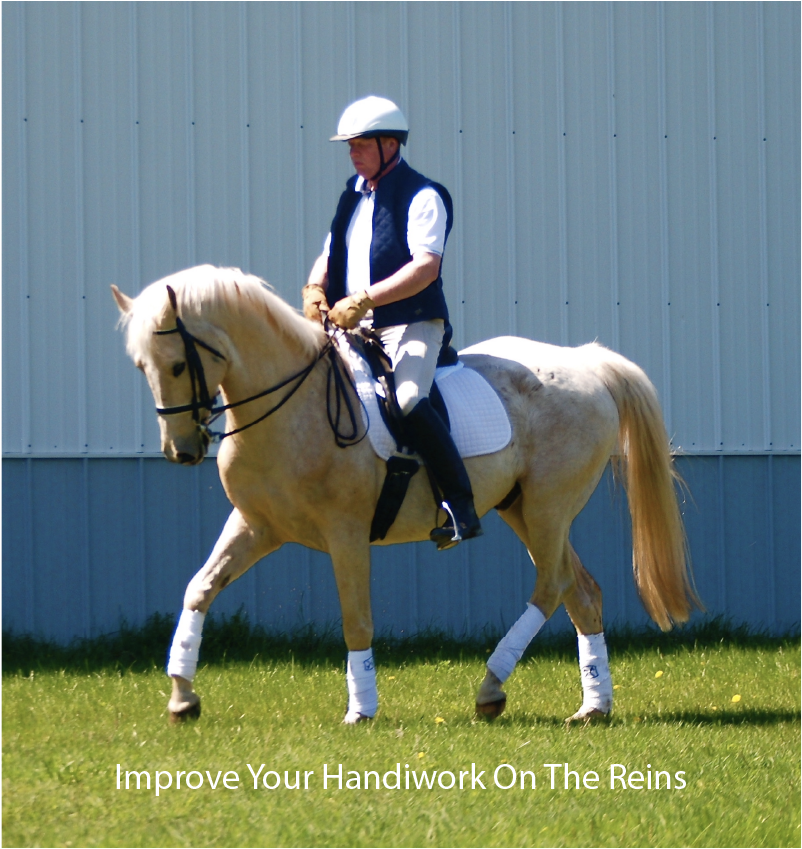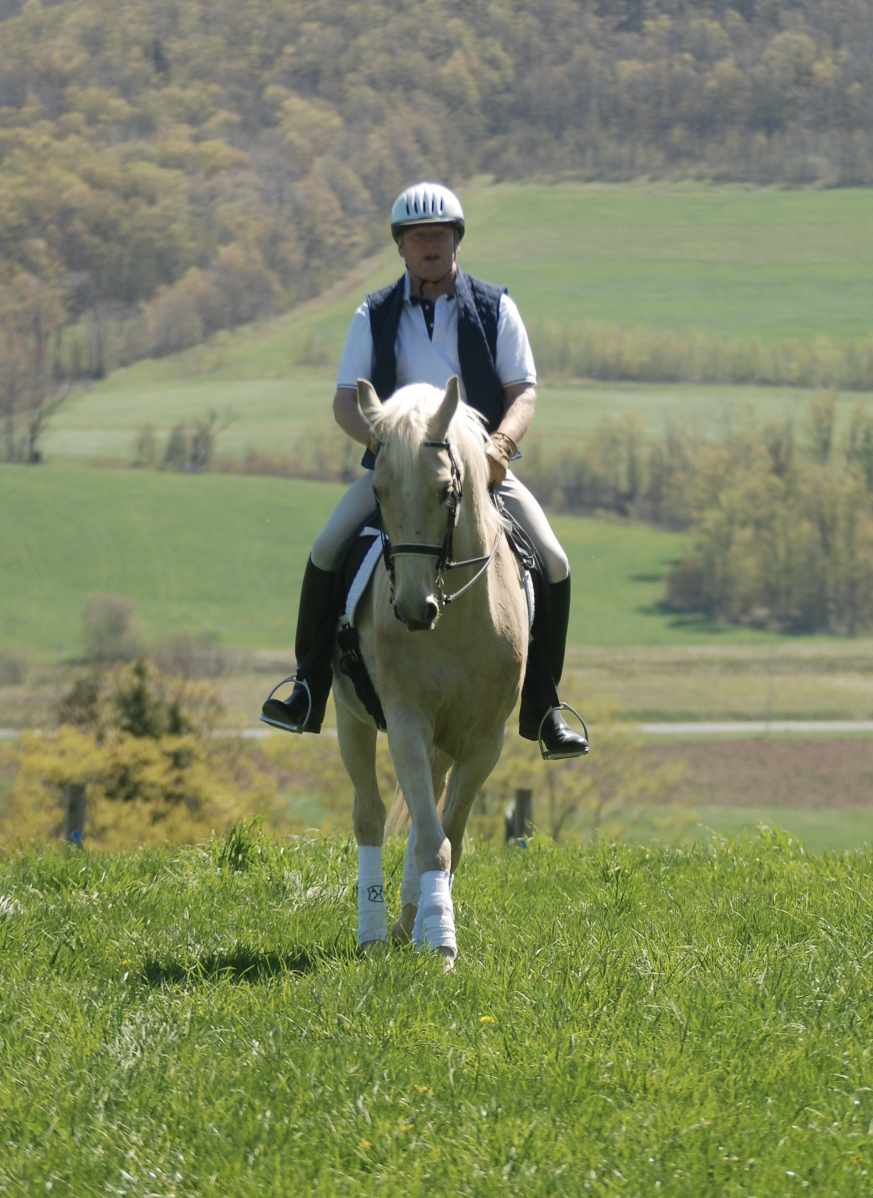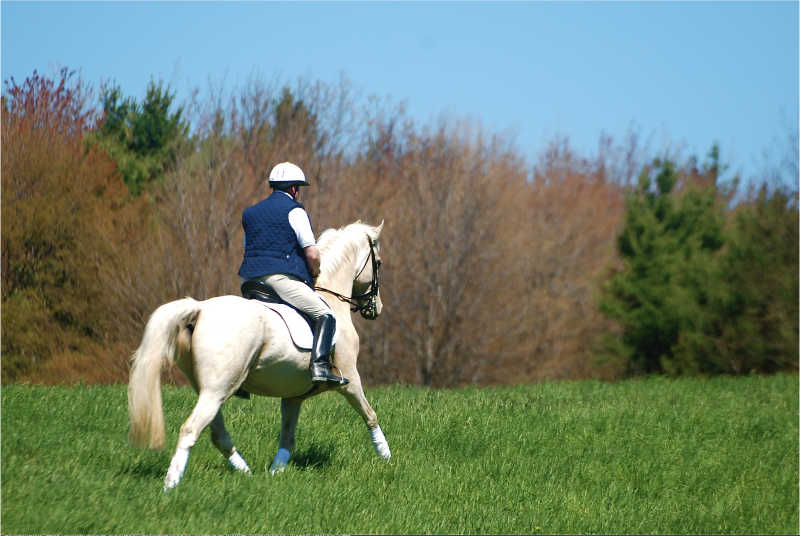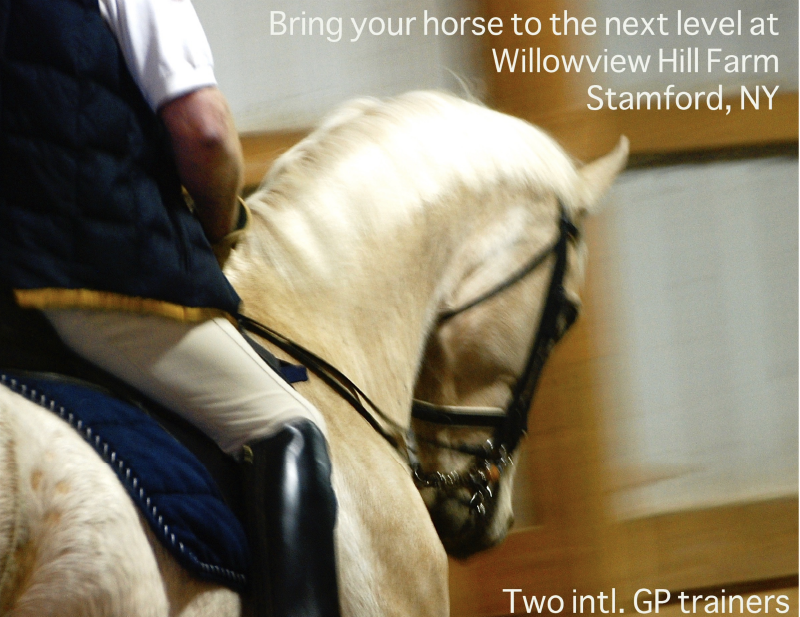Improve Your Handiwork On The Reins
by Nikki Alvin-Smith

A rider without an independent seat will almost always go to their hands to help balance themselves in the saddle. Sadly, many dressage riders manage to acquire a trained horse that is 'finished' or at least headed toward FEI level and regardless of their poor 'horse hands handiwork' they gift themselves even more leverage with the use of a double bridle.
It is not easy to develop a truly independent seat. But you can't jump this part of equestrian work without consequences in the progression of your own and that of your horse's training.
Many folks don't have access to the use of a schoolmaster longe horse where they can ride without reins, hopefully to learn how to use the seat and legs to elevate the front of the horse, to direct 'traffic' as it were, speed, cadence, collection etc. However, there are some steps the rider can take to try and alleviate the damage being done to the horse by poor handiwork in the reins.
PUT YOUR THUMBS ON TOP - STRAIGHTEN YOUR WRIST - BEND YOUR ELBOW
Yes, doing those three things will make all the difference. It's never going to fix your seat, but all three will increase your understanding of rein contact.
The 'up and down' movement of the hand during any gait but most commonly seen in the posting trot is another area where it is easy to improve yourself as a rider. Review a video of yourself and check yourself out. You may be surprised at what you find.
A downward transition is not made by lifting on the reins (or worse, pulling on the reins as well). It is done by actions of the seat and leg. Similarly, trying to execute a correct lengthening or extension is not done simply by lifting the horse up with turned hands. Remember the wider your hands are apart the harder they will also be on the horse's mouth. You cannot and should not, hold a horse up (unless you are an expert trainer doing it for a moment of correction for a specific purpose).
Poor handiwork is unfair to the horse and working on basics is what is needed to progress the rider forward. Never mind the horse. Well actually I do mind the horse, a lot. And as they can only speak by going lame, acting up, shutting down and no longer 'engaging' or trying, or clenching their jaws, I will speak for them.
Please make small simple fixes and work toward that independent seat. Don't kid yourself. You won't make it as a horse trainer or as a successful advanced rider without it.
As they say, " You can buy a great horse, but you have to earn a good seat."
There are many ways to help a rider develop a good seat and to realize their own dependence on the rein as a balancing aid.
During clinics we often ask the more 'advanced' rider to complete a lateral move like a shoulder in or even better a half pass.

Manitak, working on understanding the double bridle when used to bend. Note horse bent right, Paul's leg is 'on' left side, tapping on the right side for energy, his shoulder slightly turned right, his right seatbone active.
Correctly introducing a horse to the double bridle is one task, the other is to introduce the rider to how to properly use the four reins is quite another. They are NOT all turning reins!
Another aspect of double bridle introduction for both horse and rider is where the schooling takes place.
Working outside, where the horse will naturally be more forward and less hesitant about taking contact evenly on all four reins is a good idea, given the rider has 'earned' the use of double bridle and attained the independent seat. Hacking is a great placed to work with the double bridle once the basics of its use are understood by both horse and rider.
Once Paul had introduced Manitak to the idea of bending and accepting the leg properly as in the photo above, he then headed out across the fields to refresh Mani's acceptance of the bit. Can you see that in the first photo above, Mani was slightly behind the vertical and hesitant of the weymouth? In the photo below he is accepting the even rein contact, but he has also slightly 'set' his neck. How to rectify it would be more leg/seat and rein release but in this case Paul rectified this a few strides later by switching gait from trot to canter.

Manitak is accepting both reins contact and active legs on both sides from Paul.
If you are not able to sit with an independent seat at the trot, then it is likely you will also be unable to 'loose' the reins at the canter.
Another exercise we do at clinics is to have the rider transition their horse from trot to canter, to ascertain if they are any more secure at the higher gait.
In rare cases, a rider will be able to relax more in the canter than the trot and if they have this gift of balance we can often work with the rider on attaining their independent seat at the canter gait. Usually this is not the case.
Trainers often believe that if they plant their students on a trained horse or trustworthy longe master and spend an hour yelling at the rider in the saddle attempting to sit a trot with their stirrups taken away, that this 'training' is going to magically help the student learn an independent seat. It won't! Transitions are key to developing a good seat.
What it will help do is upset the horse by hurting its back with the repetitive bouncing of the rider hard against its back. This repeated abuse will likely result in the horse either attempting to rush forward away from the pain and/or lift its head in defense of its back hardening the trot. The result is that everything is made more difficult than ever for the rider that sits atop that is desperately seeking to attain and maintain rhythm and to stay soft seated in the saddle.
Just as the horse needs to lift his core to carry the weight of his rider and to maintain his balance, so the rider needs to lift their core to allow that to happen. Repetitive bouncing on the horse's back causes pain and suffering to both equine and equestrian.
There are many tools in the trainer's toolbox to help a student develop a soft but active seat with hopping hips, good hands and tapping legs. A student must learn how direct and indirect aids work and be able to apply them with harmony in both timing and proper degree to affect the desired result. Also importantly, this knowledge is required to maintain and develop the correct result.
If you are 'stuck' at 1st or 2nd, or even a more advanced level, know it is most likely you and not your horse causing the issue.
The remedy is to do you and your horse a favor and seek expert help. Find a trainer whose knowledge surpasses the rudimentary methods and begin enjoying working on your independent seat in lessons rather than dreading it.
There is another popular adage I used to hear that is also true:
"Be careful who you train with because you will end up looking like them," meaning riding like them in the saddle.
Effective riding should look 'pretty' as well as be effective. You do want to see almost invisible aids but also you need to learn how to easily discern their timing and application with an expert eye.
Also remember that a once-a-month good lesson with the right trainer is better than a weekly lesson with a trainer that doesn't know the big picture. Training is not about how much you spend, it's about who you spend that money with and how much knowledge, encouragement, and understanding/rapport your trainer provides.
Training is not about pounding the horse or rider around the arena. It is about understanding biomechanics and building the right muscle memory. It doesn't matter how fancy your horse is or how impressive the trainer's arena looks. It is about having fun and keeping the exuberance in the horse and happiness in the horse/human connection.

Manitak with Paul a few months later.


